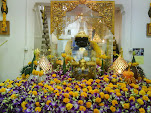 Dvaravati ( land of Buddhism) refers to the kingdom situated in the Chao Phraua river basin between the 7th and 11th centuries AD. Important archaeological objects of Dvaravati art comprise Buddhism related sculptures representing 2 distinct sect known as Theravada and Mahayana.Dvaravati Art can be sub categorized into 3 groups according to the craftmanship.
Dvaravati ( land of Buddhism) refers to the kingdom situated in the Chao Phraua river basin between the 7th and 11th centuries AD. Important archaeological objects of Dvaravati art comprise Buddhism related sculptures representing 2 distinct sect known as Theravada and Mahayana.Dvaravati Art can be sub categorized into 3 groups according to the craftmanship.
- Heavily influenced by Indian art, image have no aureole and faces are similar to Indian sculptures. Position seated with leg loosely folded or standing in the leaning pose. Hand gestures were limited to the right hand,while left hand would be shown holding the end of the robe.
- Influenced by local styles, the aureole appears in a lotus bud shape or an orb over the cranial protuberance with large hair curl. The eyebrows form a continuous "crow wings" curve, the eyes protrude while the nose is flat and the lips thick. The seated posture was in the Amaravati style with loosely folded legs. Sculptures with a diagonally draped robe would normally feature a short mantle placed over the left shoulder. The standing Buddha are mainly positioned in a straight standing pose performing the preaching posture. The robe hung to mid shin level with a symmetrical trimming.
- During the final period, Khmer influence are markedly visible. The Buddha was carved with a square face and a cleft chin. The straight adged mantle typically extended all the way to the navel. Image normally shown seated with legs fully folded, resting on a roughly carved lotus base.
胡


No comments:
Post a Comment